

Brennan Richardson's APES Solar Home Project. Silver Creek High School. One Month AP Environmental Science Study Guide. It’s that time of year.
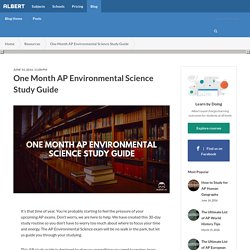
You’re probably starting to feel the pressure of your upcoming AP exams. Don’t worry, we are here to help. We have created this 30-day study routine so you don’t have to worry too much about where to focus your time and energy. The AP Environmental Science exam will be no walk in the park, but let us guide you through your studying. AP Environmental Science. Unit 6: Nonrenewable Energy - Mrs. Gretchen Whelan. Losing Earth: The Decade We Almost Stopped Climate Change. This narrative by Nathaniel Rich is a work of history, addressing the 10-year period from 1979 to 1989: the decisive decade when humankind first came to a broad understanding of the causes and dangers of climate change. Complementing the text is a series of aerial photographs and videos, all shot over the past year by George Steinmetz.
With support from the Pulitzer Center, this two-part article is based on 18 months of reporting and well over a hundred interviews. It tracks the efforts of a small group of American scientists, activists and politicians to raise the alarm and stave off catastrophe. It will come as a revelation to many readers — an agonizing revelation — to understand how thoroughly they grasped the problem and how close they came to solving it. Jake Silverstein The world has warmed more than one degree Celsius since the Industrial Revolution. Live Science: The Most Interesting Articles, Mysteries & Discoveries.
Glucose Dilution Problem. Flash Presentation. STEM Resource Finder. Lessonsinlifescience. Environmental Health Perspectives. Stories That Matter, Actions That Count. AP Environmental Science Test: Pollution. The correct answer is (C).
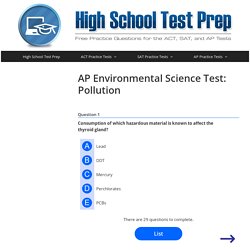
Polychlorinated biphenyls, or PCBs, are a group of industrial compounds that have caused many environmental problems. Until 1979 they were manufactured in plastics and insulating electrical transformers. Even though they are not longer manufactured, they are still present in the environment because of their long-term persistence. Dichlorodiphenyltrichloroethane, or DDT, is an insecticide designed to target nerve transmissions in pests. It was found that DDT moved up the aquatic food chain all the way up to eagles, causing eagles’ to produce thin shells that broke before the embryo developed.
Perchlorates are used for rocket fuel, and are easily leached from contaminated soil into the groundwater where they can persist for many years. Polybrominated diphenyl (PBDEs) ethers are flame retardants added to a variety of items including construction materials, furniture and clothing. Multiple choice. Multiple Choice Questions for Energy Resources - Chapter 21 Each chapter will include a few questions designed to test your knowledge of material covered in the chapter and in the Internet-based resources.
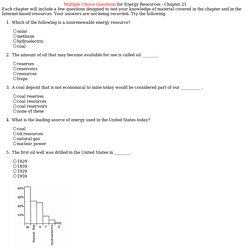
Your answers are not being recorded. Try the following. Which of the following is a nonrenewable energy resource? Solar methanehydroelectriccoal The amount of oil that may become available for use is called oil ________.reserves reservoirsresourcestraps A coal deposit that is not economical to mine today would be considered part of our __________ . coal reserves coal resourcescoal reservoirsnone of these What is the leading source of energy used in the United States today? Return to the Physical Geology Home Page. APES - Dr. Brown, Brookline High School. Chapter 12 Nonrenewable Energy. Mrs. Paul - Biology: Advanced 2016-2017 Biology Notes. Field Study Procedure Frame Nitrogen Cycle Equilibrium, Feedback, Flows Conclusions Evidence of Evolution Natural Selection.

Chapter 4: Biomes. Shannon diversity lab. Lecture and Labs. Is wood a green source of energy? Scientists are divided. It took half a century for an acorn to grow into the 20-meter-tall oak tree standing here in a North Carolina hardwood forest near the banks of the Northeast Cape Fear River.
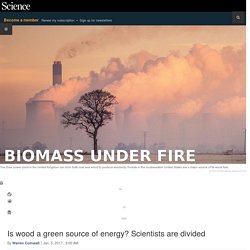
But it takes just seconds to turn the oak into fuel for the furnace of a European power plant. A logging machine—a cross between a tank and a one-armed crab—grabs the tree with a metal claw. With a screech, a spinning blade bites through the trunk. Ultimately, the thickest bits of this tree and hundreds of others from this forest will be sliced into lumber. But the limbs from large trees like this, along with entire small or crooked trees, go to a specialized mill to be squeezed into tiny wood pellets. The idea is attractively simple, says Abt, a member of an expert panel that is studying the concept for the U.S. Ecocolumn instructions. TEXTBOOK RESOURCES - Venice High APES. Living in the Environment PDF.
Ch. 1 - State of Earth/Env. Systems - Mrs. B's Science ScoopBeachwood High School. [PDF] [EPUB] Friedland Relyea Environmental Science For Ap* Download. Footprint Calculator - Global Footprint Network. AP Environmental Science - South Sevier High School. Environmental Science for AP (9781464108686) Lawyers in California correlates with Occupants of pick-up truck or van killed in collision with car, pick-up truck or van. Lawyers in California inversely correlates withOccupants of pick-up truck or van killed in collision with car, pick-up truck or van Upload this image to imgur.

The Plastic Tide » Classify — Zooniverse. 1.
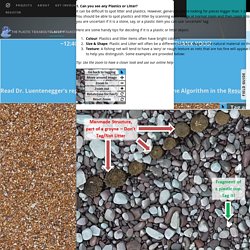
Can you see any Plastics or Litter? It can be difficult to spot litter and plastics. However, generally you're looking for pieces bigger than 1-2cm which are visible at normal zoom. So there maximise zoom and scan the image that way. Wildcamgorongosa. Data Nuggets. Dr. E Science Page - Dr. E's Science Page. APES Unit 1-Intro to APES. AP Environmental Science - APES. AP Environmental Science - Notes and Handouts. "The Earth does not belong to us-- we belong to the Earth.

" -- Chief Seattle, 1854 TEXTBOOK: Wright, Richard T. Environmental Science: Toward a Sustainable Future. Upper Saddle River, NJ: Pearson Prentice Hall, 2005. SUPPLEMENTARY RESOURCE: Morrow, Angela and T. Ligget. NOTE ON OPENING LINKS: If a link does not open, right-click on the link and save it to a location such as your desktop or documents folder.
"REFRESHING" THE PAGE: Please "refresh" this page each time you access it to be sure you are not accessing an older version of the page in your computer's memory. NOTE ON PAPER COPIES: I will photocopy or print any document for any student, as long as the request is made ahead of time and not the day we are doing the activity. Students may download the notes and keep them in the electronic format. Class Notes - AP Environmental Science. Chapter Outlines - Mr. Dineley's AP Environmental Science. How I Got a 5 on the AP Environmental Science Exam! The Ultimate List of AP Environmental Science Tips. AP Environmental Science doc syllubus 2015 16. 2016 2017 ap environmental science pacing calendar final. APES - Ms. Steven's Website. AP Environmental Science. Below is the powerpoint for Chapter 5.
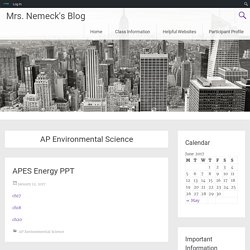
This ppt is not as detailed as previous ones; you should read the chapter and refer to the diagrams that you drew in class in order to have a keen understanding of how each element cycles. Ap environmental science course description. AAAPESPacing11studentsrevised.doc. Ap environmental science pacing guide. Franks, Chad / AP Environmental pacing. WIG14c2fde921a551e784b279c236bd55c3. New Video: Jo Boaler On Learning, Mistakes & The Brain. I’ve previously posted about Jo Boaler’s work (see Great New Video: “When People Make Mistakes Their Brains Grow, More Than When They Got Work Right”).

Thanks to Dan Meyer, I learned that her TEDx Talk was just posted today. It’s titled “How you can be good at math, and other surprising facts about learning” and it’s definitely not just applicable to math. I’m adding it to The Best Resources For Showing Students That They Make Their Brain Stronger By Learning: Related Fascinating Study On What Learning From Mistakes Does To The Brain. Can You 'Catch' Stress in a Classroom? Science Says Yes. Head lice and strep throat aren’t the only things you can catch in a classroom. According to a new study from Canada, stress may be contagious, too. Researchers found that when 4th- to 7th-grade teachers reported feeling "burned out," their students also had elevated stress levels. The study "is the first of its kind connecting teachers' stress-related experiences to students' stress physiology in a real-life setting," the researchers wrote in their study, published today (June 27) in the journal Social Science & Medicine. [10 Scientific Tips for Raising Happy Kids] Teacher burnout is likely the leading reason for which teachers leave the profession, according to the study.
Previous research suggested that teachers who report higher levels of burnout also report having higher stress levels as well as being less effective in their classroom management and their teaching, the researchers wrote.